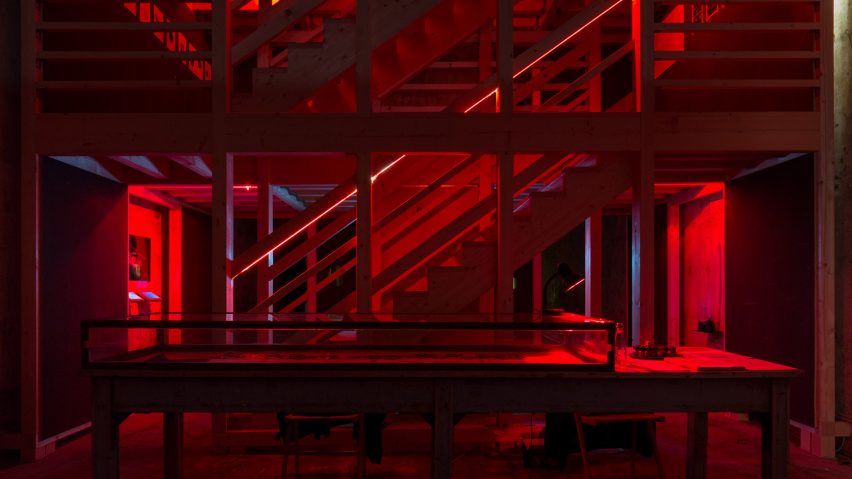The practice of cruising is changing the way that buildings are designed, according to the curators of a Venice Architecture Biennale exhibition that brings together sex and architecture.
Featuring a flatpack maze containing a glory hole, and artefacts from famously secretive Berlin nightclub Berghain, the Cruising Pavilion explores the subversive architecture of, and architectures subverted by, casual sex.
The term cruising refers to the practice of moving through a space to find a casual, sometimes anonymous, sexual partner.
According to exhibition curators Pierre-Alexandre Mateos, Rasmus Myrup, Octave Perrault and Charles Teyssou, cruising has shaped the design of numerous types of buildings and spaces, from public toilets and parks, to bathhouses and nightclubs.
"Cruising is a topic that is present in architecture, but is always latent or silenced, or never expressed fully," Perrault told Dezeen.
However the group claim that the historical model of cruising is "evolving and perhaps even dying", and that sex is starting to impact other types of architecture. For instance, the use of dating app Grindr is moving sex out of gay bars and into contemporary condos.
They are calling for architects to embrace this culture, rather than trying to sanitise or expunge sex from building design, but also to respect its secretive nature.
"I think it's a very ambiguous position to occupy," said Perrault. "Homophobia and homophobic crimes are far from being a thing of the past. The secrecy and the in-articulation are ways to protect practices that are still very de-legitimised and still at the core of very vivid political tensions."
The Cruising Pavilion is taking over arts space Spazio Punch, on Venetian island Giudecca, for the duration of the biennale.
Responding to the biennale title Freespace, the exhibition uses a range of unusual exhibits to celebrate recent examples of architecture that have allowed partners – both homosexual and otherwise – to find sexual freedom in public places.
It also focuses on how the practice has been impacted by the digital age.
Visitors enter a series of dark spaces lit dimly with red lamps, and have to climb flights of wooden stairs to ascend two towers that have been constructed within the space. Here, art pieces are pinned or pasted to walls, projected on screens or found on floors.
A piece by artist Trevor Yeung perfumes the air. His work, called The Helping Hand, is a misting machine of the kind typically used to keep reptile tanks moist, but for this occasion it is filled with eucalyptus oil to recreate the scents used in gay bathhouses to cover the sent of sex, sweat and bodily emissions.
Swallow, Pump and Choke are scanned and printed pencil drawings by Alison Veit, who imagines a fantasy club for women to cruise for other women, while a series of photos by Prem Sahib shows the taking apart of gay bathhouse Chariots in east London, ahead of residential developers moving in.
Also on display is artist Andreas Angelidakis' Cruising Labyrinth, an "IKEA-style" flatpack comprising panels of prefabricated black-painted plywood that can be arranged by the user to create a maze leading to the pinnacle of anonymous sex, the glory hole.
In the space between the two platforms, the floor is strewn with "used" condoms and silk scarves that have been printed with texts that explore themes of intimacy, prophylaxis and contagion by artist Lili Reynaud Dewar.
German architecture practice Studio Karhard has chosen to display a lighting fixture designed by Dominique Perrault and manufacturer Sammode, which is used in Berlin's Berghain.
The studio had originally intended to show the architectural plans of the infamous cruising spot, but the club is so fiercely protective of its punters' privacy that, along with a no-photos policy, it also refuses to release drawings of the building.
The maze-like layout of the exhibition space reflects the labyrinth as both an architectural tool found in cruising spots such as nightclubs and gardens, and a metaphor for the hidden nature of the activities that take place inside them.
"For me, the labyrinth is a device that can be protective and an escape from heteronormativity," said Perrault.
"It is particularly interesting because, for basically the last 200 or 300 years of architecture, the maze was to be avoided as a form linked to immorality," he explained. "Everything had to be ordered, placed, named, oriented, because that's what made the city safe, controllable, surveilled, efficient and productive."
Embracing labyrinthine layouts then becomes a radical act, inspiring "architecture that is not only about constructing gender and relationships, but actually liberating".
The Cruising Pavilion is open at Spazio Punch until 1 July 2018. Guests at the opening party were offered poppers and condoms along with their champagne.
Photography by Louis De Belle.

